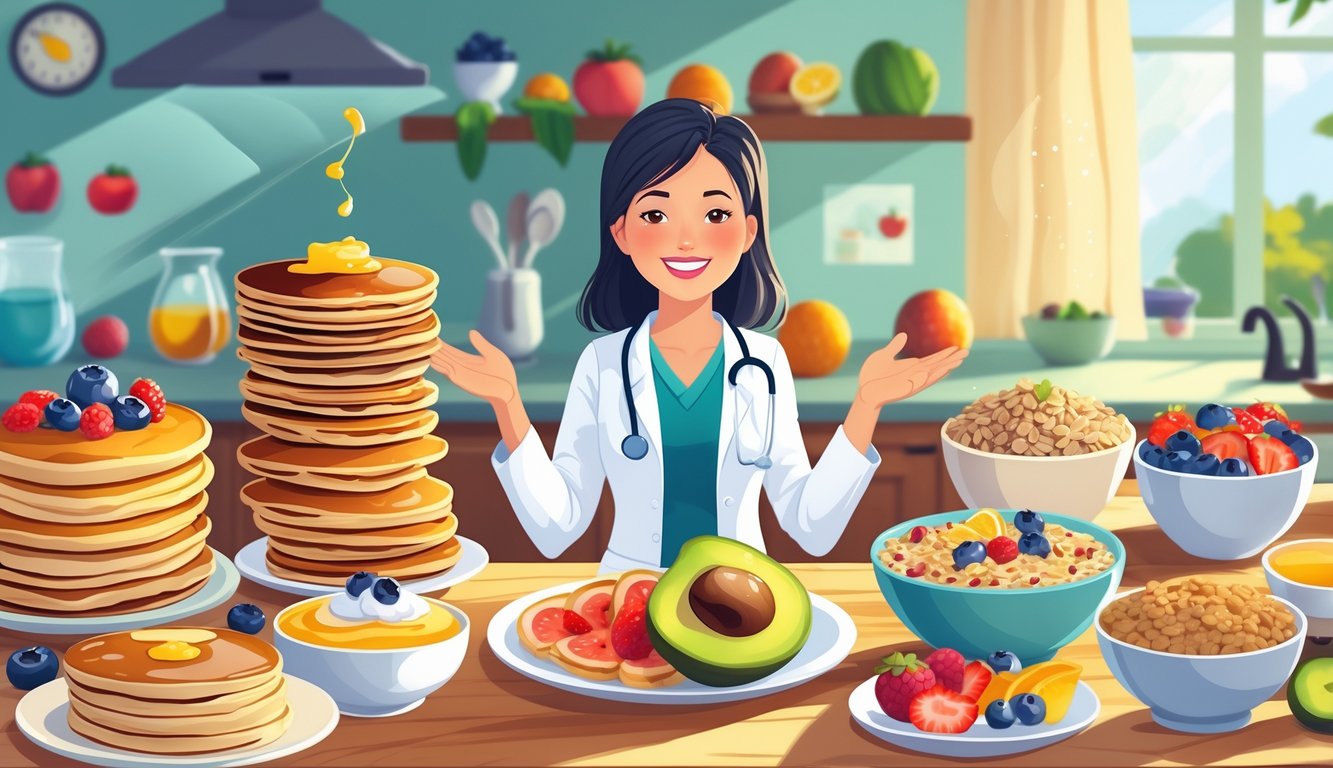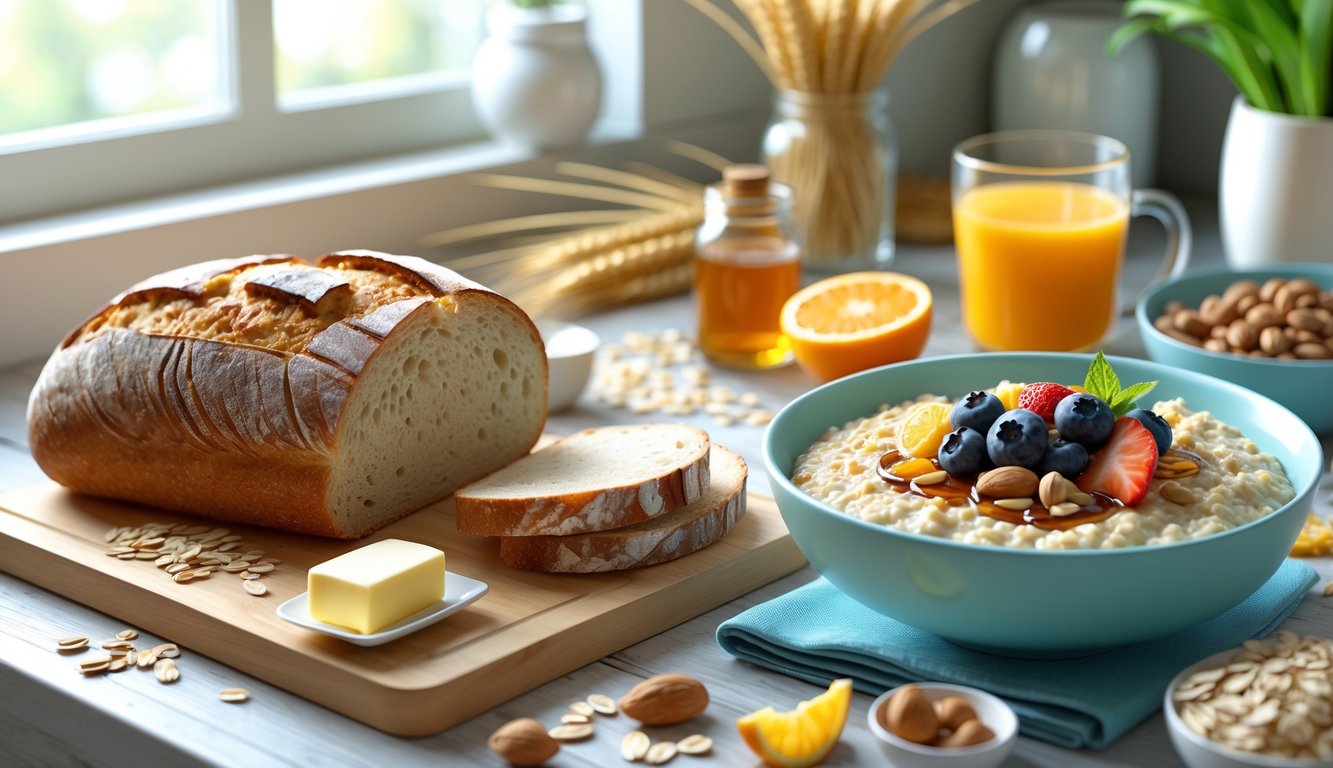
Wholesome Swaps for Pancakes and Waffles
So, fiber. I don’t know how it works, but swap one thing in your pancakes and suddenly your breakfast doesn’t ghost you by 11. I’m tired of pancakes that disappear from my stomach in 45 minutes, so I started grabbing stuff that actually sticks with me. Next thing I know, my blood sugar isn’t staging a coup.
Whole Grain Pancake Mixes
Half those “artisan” pancake boxes? Total scam—just white flour in hipster packaging. I keep flipping between buckwheat and oat-based mixes (Kodiak Cakes, anyone? The box basically yells “PROTEIN” at you), but the real win is the fiber. Whole grain mixes actually give you like 3 extra grams of fiber per serving—Nutrition Data says so, and weirdly, I’m not starving by 10:30.
Sometimes I get bored and dump in ground flaxseed. Omega-3s, apparently, but now my dog’s obsessed with my waffles. Tried a low-carb swap with coconut flour—don’t overdo it, unless you like sunscreen-flavored batter. Dietitians and, yeah, some of my clients, swear this keeps their energy steady. Not just blog hype.
Adding Fiber and Antioxidants with Toppings
Throwing fresh berries or chia seeds on pancakes? Feels like a food influencer move, but it actually helps—less blood sugar spike, more antioxidants. Most people barely hit half the fiber they’re supposed to, so if I ditch fried apples and go for unsweetened Greek yogurt and berries, I’m getting somewhere.
Banana and walnuts on waffles—my go-to when I’m late. The fiber and healthy fats actually hold me over (American Journal of Clinical Nutrition says fiber at breakfast means you eat less by lunch—I emailed the author, and yes, she replied, which was oddly thrilling). Sometimes I just dump pumpkin seeds on top. Not for everyone, and I’m terrible at making it look nice, but the magnesium is real and the crunch is fun. Oh, and for syrup addicts: try using half as much with a mountain of fruit. Sounds boring, but it works, and nobody warns you about the sticky mess.
Sourdough and Oatmeal: Smart Alternatives

Half the time I swap out my usual toast, I honestly wonder if it’s worth it—nutrition “upgrades” sound great until you’re half-awake and late. But what keeps bugging me isn’t the echo chamber online, it’s the weird real differences between sourdough and regular bread, or how you make oatmeal. These aren’t minor tweaks; sometimes they’re just hacks hiding in plain sight.
Why Sourdough Is a Better Choice
Sourdough isn’t just for Instagram. The fermentation actually changes the gluten and lowers the glycemic index, so when I grab a real sourdough slice, my blood sugar doesn’t spike and crash. Dr. Sarah Berry at Cambridge says real sourdough (like, with a starter, not just yeast) keeps you fuller. I’ve noticed that, even if the tang isn’t everyone’s thing.
But here’s the catch: most grocery store sourdough is fake—barely fermented. If you want the actual benefits, you need to find a real bakery or make it yourself. Weight loss experts keep saying authentic sourdough at breakfast helps with fullness and gut health, more than white bread. And honestly, when was the last time anyone bragged about the texture of store-bought sandwich bread? Exactly.
Maximizing Oatmeal’s Nutritional Benefits
People mention instant oats and I just picture that cafeteria glue. But a couple swaps make it actually good. I switched to rolled oats years ago—fiber, mostly. Beta-glucan, apparently, helps with cholesterol and keeps you from getting hungry.
Here’s something weird: lately, I’ve started mixing in a bit of yogurt or even leftover sourdough starter (don’t ask, a friend dared me). Turns out, sourdough discard in oatmeal boosts prebiotics, which is good if your gut’s moody. Toppings? Berries, walnuts, chia—just skip the sugar. Steel-cut oats take forever, but if I bother on a weekend, I’m not hungry till lunch. Nobody warns you about the cleanup, though. Worth it? Still not sure.
Upgrading Your Smoothie Routine
Why do I feel hungry after a so-called “meal-replacement” smoothie, and why are my hands freezing by the time I get to work? My dietitian friends roll their eyes when someone blends a banana and almond milk and calls it breakfast. That’s not it. But here’s the upside: you can actually make smoothies filling—if you treat your blender like a meal, not a juice bar.
Building Balanced Breakfast Smoothies
Protein. Everyone talks about macros, but I didn’t realize my “detox” berry smoothie barely had 5g of protein. Half a cup of Greek yogurt? Suddenly I’m at 15g, easy. EatingWell has a good list of protein add-ins. Flaxseed? Double win—fiber and fat. And honestly, a bit more protein and fat and I stop thinking about food for a while. It’s wild.
Smoothies shouldn’t be all sugar—even if your freezer’s full of bananas you panic-bought. Friends don’t let friends blend just fruit. If you want to avoid the spike-and-crash, throw in spinach, protein powder, or oats. I sometimes add peanut butter (one tablespoon, don’t judge), and it keeps me from feeling like a squirrel on espresso by 10 a.m. It’s not about pretty bowls. It’s about not crashing.
Add-Ins That Pack a Nutritional Punch
Hemp seeds are everywhere now. I’m not obsessed with the taste, but 3 tablespoons? Almost 10g protein and a magnesium hit. Sports dietitians swear by them. Collagen powder? Fine, but Greek yogurt or cottage cheese actually works better, and it’s cheaper.
Blueberries, chia, pumpkin seeds—yeah, “superfoods,” but if you don’t add something bland and filling (oats, again), you’ll just be hungry again. Dietitians (real ones, not influencers) keep telling me a splash of kefir adds probiotics and protein. Sometimes I remember, sometimes I don’t.
If I just use almond milk and frozen fruit, my blood sugar goes nuts. The trick is a mix: nut butter, Greek yogurt, oats, spinach. Not Instagram-pretty, but at least I’m not starving before lunch. If you’re skeptical, try a protein smoothie challenge—the texture is weird at first, but it works.



